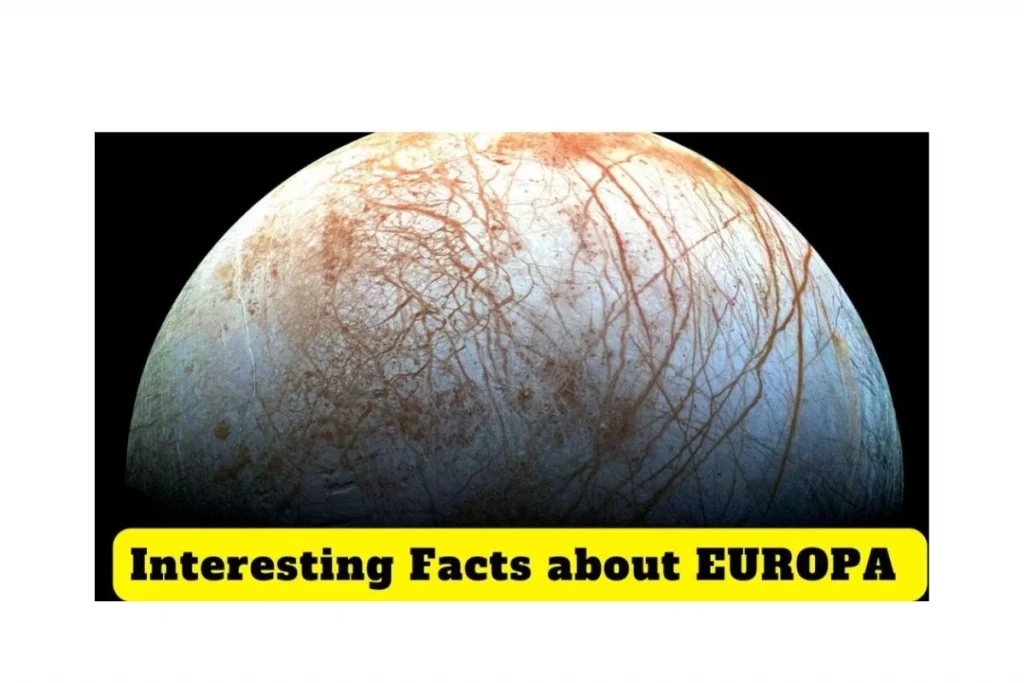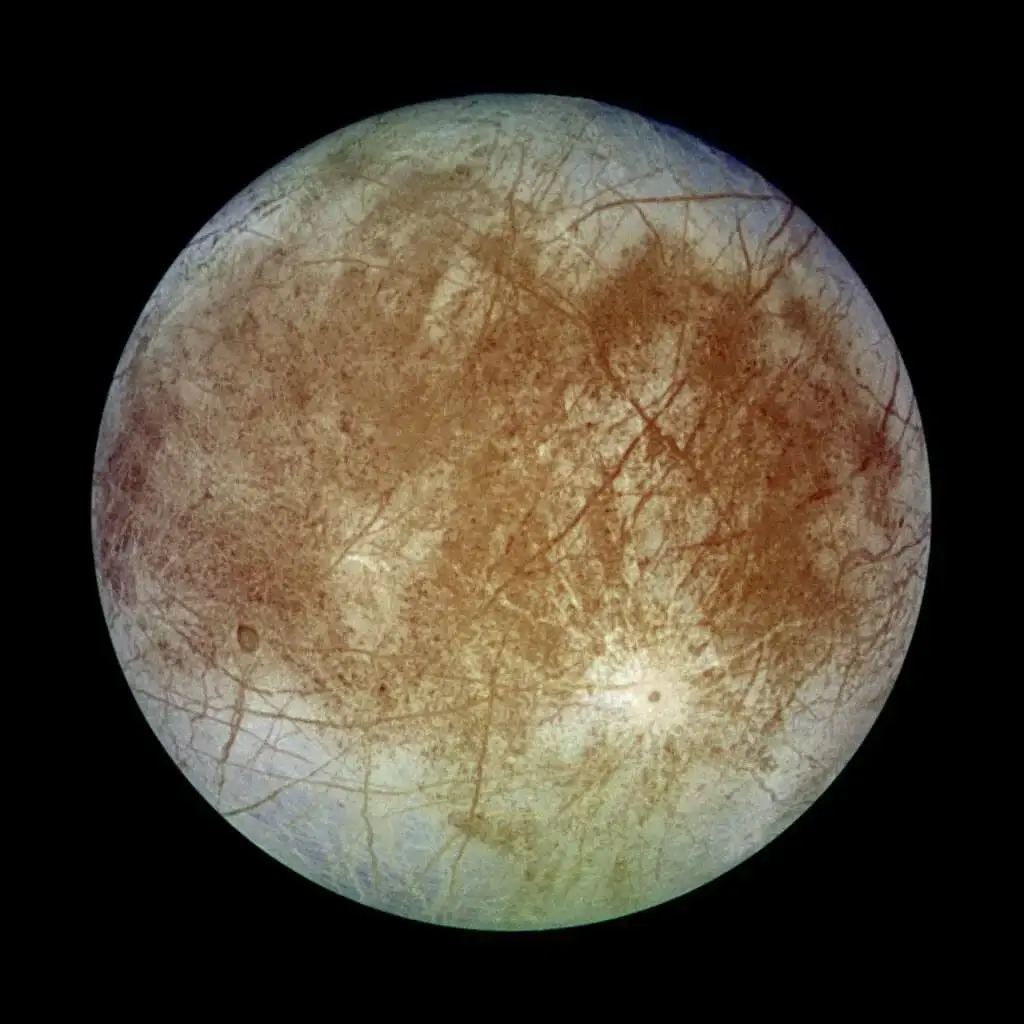
Galileo discovered Europa, which is one of the largest moons in our solar system. Being Jupiter’s moon, it has always been the source of curiosity among observers. It has an ice surface. Therefore, its other name is the Icy Moon. Did you know, that the icy surface of Europa is the most reflective in the solar system?
It has an ocean below the frozen surface. In 2012, researchers spotted water plumes through the Hubble Space Telescope on its south pole. In 2014 and 2016, similar water plumes were observed by another observing team. This confirmed the presence of an ocean below the surface. It not only has water bodies but also has the possibility of the presence of extraterrestrial life.
Did these facts spark your curiosity?
Then stick to the end of the article. In the next part, we will discuss more interesting facts about Jupiter’s this Icy moon.

Quick facts
- It is the sixth satellite of Jupiter.
- It is 4.5 billion years old.
- Its diameter is 1900 miles around 3100 km.
- Its distance from Sun is 485 million miles i.e., 780 million kilometers.
- Its distance from Jupiter is 414,000 miles.
- On Europa, the temperature at the equator never falls below -160°C. However, at the poles the temperature never falls below -220°C
About Europa
It was discovered by Galileo along with the other Jupiter’s moon Ganymede, Callisto, and Lo. Simon Marius discovered Europa at that same time. However, he did not publish his observations and therefore Galilio is credited with the discovery of the moon.
Did you know?
Europa’s discovery confirmed that planets revolve around the Sun.
A characteristic feature of it is the reflectivity of Europa’s surface. The albedo and light reflectivity of Europa is 0.64. Which is the highest among all the moons in the solar system.
It takes 3.5 days for Europa to travel around Jupiter. It is tidally locked which means only one side of it faces Jupiter all the time. While orbiting, it is possible for the orbits to turn circular. However, resonance produced by the three satellites from Jupiter creates forced eccentricity. This produces a gravitational pull that prevents the orbits from getting circular.
Structure of Europa
Photographs of this moon suggest that it is made from silicate rock and has a rocky mantle and iron core. In the interior, there can be ice layers as thick as 105 miles.
In fact, Europa showcases one of the most unique surface structures in the solar system. The icy surface has linear structures crisscrossing each other. Blotchy reddish browns are present on the surface. They can be the result of sulfur and salt compounds, mixed with the water ice and affected by radiation.
The tidal waves beneath the icy structures cause cracks on the surface of Europa. As it orbits around Jupiter, the tides tend to rise higher than usual. The constant raising and lowering of the tidal waves have resulted in cracks on the surface of the moon. The cracks are more than 20 kilometers long.
It also harbors tectonic plates that result in a dynamic crust and further confirms the idea of supporting life. Its magnetic field shows fluctuations. This indicates the presence of conductors inside the surface. Europa’s subsurface ocean’s liquid saltwater may act as an electrically conductive material.
There is a slight possibility that the surface of Europa is rotating faster than the inner regions of the moon. The surface houses several freckles which can be domes, pits, or smooth dark spots. Popularly known as chaos. These jumbled spots appear as icebergs embedded in the sea.

Can it support life?
Scientists believe that the ocean present beneath the icy layer can contain some source of life. Recent studies confirm the fact of supporting life. But the presence of extraterrestrial life is always debatable. The icy depth of the moon contains vents. These vents can provide a sufficient thermal environment that can support the evolution of life.
A study in 2016 revealed that Europa produces ten times more oxygen than hydrogen. It is similar to Earth. Europa is a great candidate for supporting extraterrestrial life. But radiation on Europa is enough to kill a human being in a day. Radiation on the surface of Europa is around 5400 mSv per day. This amount of radiation causes severe illness and death.
The high radiation levels are because of energetic particles from Jupiter’s magnetic field. Europa has a weak oxygen atmosphere. It is because the charged particles from the sun break the oxygen and hydrogen particles on the surface. Jupiter’s gravity also disrupts the atmosphere of Europa.
Missions to Europa
- Pioneer 10 (flyby of 1973 Jupiter system): It passed too far away from Europa. But observed significant changes in the brightness of the moon.
- Pioneer 11 (flyby of 1974 Jupiter system): It observed variations on the surface of Europa.
- Voyager 1: It observed the significance of the moon’s gravity.
- Voyager 2(flyby of 1979 Jupiter system): This mission studied the brown stripes observed on the surface of Europa. Which suggests cracks on the frozen surface.
- Galileo: This mission identified the ocean beneath the icy surface.
- Europa Clippers: It searched for evidence of water plumes. Which were observed through the Hubble Space Telescope.
- Jupiter Icy Moons Explorer (JUICE): This mission will seek evidence of organic molecules on Europa’s surface.
There will be several future missions to Europa. These missions will provide information about the chemical composition, extraterrestrial life, and the subsurface oceans. As there is radiation on the surface of Europa. A robotic mission will also be sent in the future.
So these are some of the interesting facts about Europa. The existence of extraterrestrial life on Europa is debatable. Europa will always be a source of curiosity.
We hope you liked the content of this article. If you want to know more about such interesting objects in space then check out our website for more stargazing & astronomy-related content. Also, check our Youtube channel for awesome video content.





